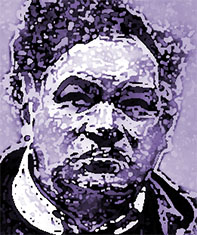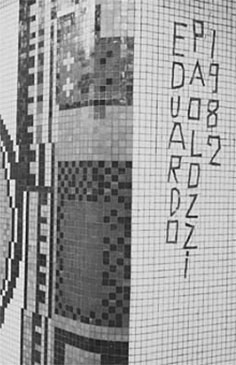- Screen Colours:
- Normal
- Black & Yellow
Growing up in my formative years ‘Over Stoke’, I was acutely aware of the engineering manufacturing base of Ipswich, from Ransome Sims & Jefferies, Cocksedge and Compair Reavell to my late father’s employers Ransomes & Rapier Ltd at the Waterside Works.
My father was employed as a quality control inspector. For many years his job entailed him travelling around Ipswich and across the UK, carrying out quality inspections on components being manufactured for Rapier machines by a wide variety of specialist engineering companies, both large and small. As a manufacturing centre, in my Oxfordshire ‘exile’ years in the mid 1980s, I remember often driving on the Coventry Ring Road and seeing the multitude of component companies serving the Ryton Motor Works. Ipswich also had, for many years, several smaller engineering companies in and around the environs of the town. One such company was C. W. Juby Ltd. of Whitehouse Road.
 Fast forward to my teen years. Eventually in 1968, I became friendly with Dave, who was an articled clerk for a chartered accountancy practice but who had, after leaving grammar school, gone initially to Maidstone College of Art to study sculpture. By the end of the decade we had transformed ourselves by growing our hair longer: from mods into blues-loving hippies. Our rendezvous was always the Vaults Bar of the Golden Lion Hotel on the Cornhill in Ipswich.
Fast forward to my teen years. Eventually in 1968, I became friendly with Dave, who was an articled clerk for a chartered accountancy practice but who had, after leaving grammar school, gone initially to Maidstone College of Art to study sculpture. By the end of the decade we had transformed ourselves by growing our hair longer: from mods into blues-loving hippies. Our rendezvous was always the Vaults Bar of the Golden Lion Hotel on the Cornhill in Ipswich.
Treated portrait of Eduardo Paolozzi.
One evening we started a casual conversation with Kevin and his school friend, John. Either on that occasion, or on a subsequent one, Dave mentioned his interest in sculpture. The conversation eventually then turned to Eduardo Paolozzi, to which Kevin replied that his father worked for Juby’s engineers as a welder, and had been responsible for assembling the works of art! Having myself been to different sculpture parks, and in particular the Henry Moore Foundation near Bishops Stortford, it is easy to understand why the artist/sculptor often needs someone else to build their vision. Indeed, Anthony Gormley now has his own works in London, but in earlier times would have needed others to cast the life-size effigies of himself.
Sir Eduardo Paolozzi was born in Scotland and was the son of Italian migrants. He studied in Edinburgh and London, worked in Paris and eventually established a studio in London. In the mid-1950s he moved to Thorpe Le Soken in Essex. He was a founding member of the British Pop Art movement, producing lifelike works with cubic elements. In the 1960s and 1970s he produced many machine like sculptures, some of which were in the Tate Gallery for many years.
Len Smith of Elmcroft Road, was a skilled welder for many years and, between the period 1962-1971, whilst at Jubys he worked with Paolozzi, assembling his sculptures. When interviewed once on Look East he modestly said that he just followed the sculptor’s instructions. However, Paolozzi often worked in aluminium and bronze, and these materials would require exceptional skill to be welded into the right positions on the sculpture. Many of the castings were produced by another Ipswich engineering firm, but assembled at Juby’s. Paolozzi had the vision, Len’s skill made his ideas reality.
Len helped assemble Paolozzi’s works when they were exhibited, and on occasions the sculptor had lunch with Len at his home. A friendship over many years had developed. Sadly, both Len and Eduardo have passed on, but the links of the international sculptor with the engineering craftsman need to be brought out more into the mainstream and recognised.
 If in the future, when I travel through Tottenham Court Road underground station, I will appreciate the Paolozzi mural which is there, in the knowledge that a skilled engineer played an important part in the sculptor’s career.
If in the future, when I travel through Tottenham Court Road underground station, I will appreciate the Paolozzi mural which is there, in the knowledge that a skilled engineer played an important part in the sculptor’s career.
Graham Day
(My thanks are due to my own memory and the Ipswich remembers Facebook group.)
[Eduardo Paolozzi (1924–2005) was also a visiting lecturer at the Ipswich School of Art. He opened the present Art School§ in 1987 and he was knighted in 1989. Eduardo Paolozzi: General Dynamic F.U.N., a Hayward touring exhibition from London’s Southbank Centre, featured in the Art School Gallery in January 2017.
His links with East Anglia extended to moving his family to Thorpe-le-Soken in Essex in 1955. Founded in 1954 by Nigel Henderson and Paolozzi, Hammer Prints Ltd was established to create textiles, wallpaper, statuary, ceramics, furniture and more, working from a studio at Henderson's home at Landermere Wharf near Thorpe-le-Soken. Hammer Prints coincided with the artists’ involvement in the Independent Group, a contingent of artists, architects and writers who celebrated popular culture and mass production. Paolozzi's notes stated: ‘it is the object of Hammer Prints Ltd that an attack be made on the craft field using the silk-screen as the media to be exploited.’ –Ed.] §See correction in the January 2021 Newsletter.